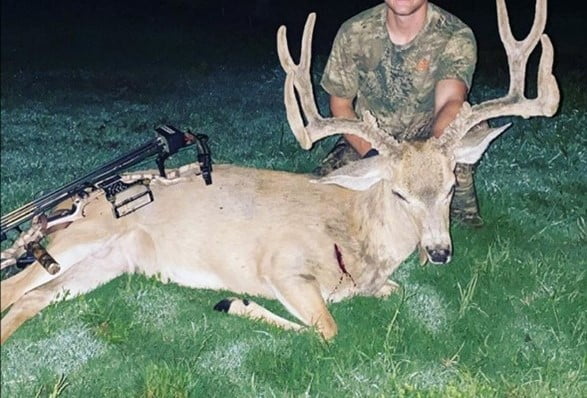
JEFFERSON CITY, Mo. — With fall firearms turkey season and archery season underway, the Missouri Department of Conservation (MDC) advises hunters it could be a challenging season.
This year’s annual wild turkey brood survey shows statewide turkey production was below average. The statewide poult-to-hen ratio (PHR) for this year was 0.9, which was 13% higher than last year’s ratio, but 25% lower than the previous five-year average. Regionally, PHRs ranged from 0.7 in the Ozarks West to 1.4 in the Northwest region (see related map). Turkey production was higher in north Missouri this year than in the southern part of the state.
MDC Turkey Biologist Jason Isabelle indicates that although this year’s late spring delayed nesting, conditions during the nesting and brood-rearing periods were favorable throughout much of the state. Yet, despite favorable weather, Isabelle indicates that this year’s low production isn’t surprising when you consider the trend in PHRs from previous years.
“During the late 1990s, turkey production steadily increased before declining during the 2000s. After once again increasing throughout much of the state from about 2009-2014, we experienced lower production during the last three years,” said Isabelle. “The PHR trend the last several years would have suggested production was going to be low this year.”
Isabelle adds that because weather often varies considerably from one year to the next, MDC staff would expect to see much more variability in the PHRs if annual weather variability was the primary driver of turkey production.
“The longer we collect turkey production data, the more it appears that annual variability of weather may not be quite as influential as we once believed,” said Isabelle. “That’s not to say that weather doesn’t affect turkey production. However, the cyclical patterns we’re seeing in PHRs suggest it’s a bit more complicated than that.”
Isabelle acknowledges there is still much to be learned about the factors that affect turkey production—something he and his colleagues are working on.
“We’re looking at our long-term turkey brood survey dataset and trying to tease apart how turkey numbers, weather, landscape, and their interactions affect production. This research should help explain some of the trends we’re seeing in turkey production,” Isabelle said.
The good news—Isabelle expects turkey production to bounce back.
“The pattern we’re seeing in PHRs would suggest that turkey production will steadily increase during the coming years,” he said. “This would certainly be welcomed given the production we’ve experienced the last several years.”
How the poult-to-hen ratio is determined

Each summer, as part of the state’s wild turkey brood survey, MDC staff and citizen volunteers record the number of hens and recently hatched turkeys they see, which are called poults. These observations are then tallied to determine the success of the hatch, which is most often reported as a poult-to-hen ratio, or simply the average number of poults per hen observed during the survey. Isabelle explained that the poult-to-hen ratio is a good measure of nesting success and poult survival.
“Each year, thousands of citizens participate in the survey and we are grateful for their contribution,” Isabelle said. “During the three-month survey, participants typically report sightings of 60,000-80,000 turkeys, which is a testament to the large number of dedicated volunteers that take time to participate in the survey each year.”
Fall hunting prospects
With below-average production throughout much of the state, Isabelle says fall turkey hunting is going to be more challenging this year.
“Because we have fewer young birds on the landscape this year, hunters are going to have to put in more time to be successful. This will be especially true in areas where we have good acorn production, which tends to shift turkeys out of open fields and into the timber, and also reduces their movements,” he said.
Isabelle noted that relatively few people hunt turkeys during the fall season, which results in low hunting pressure and little competition among hunters. Unlike the spring season, when about 100,000 turkey hunting permits are purchased in Missouri, typically only about 10,000 hunters purchase fall firearms turkey permits.
“Although the woods tend to get a bit busier towards the end of October with the deer rut approaching, hunting pressure is relatively light during early-to-mid-October, even on public lands,” said Isabelle.
Hunting hours for the fall firearms turkey season, Oct. 1-31, are from one-half hour before sunrise to sunset. Fall archery turkey hunting runs from Sept. 15 to Nov. 9 and resumes Nov. 21 to Jan. 15. Shooting hours for the archery season are one-half hour before sunrise to one-half hour after sunset. Both seasons have a limit of two turkeys of either sex. Details about fall turkey hunting regulations can be found in the 2018 Fall Deer and Turkey Hunting Regulations and Informationbooklet available wherever hunting permits are sold, from MDC offices and nature centers, or online at https://bit.ly/2pamBwF.
Buy permits from vendors around the state, online at mdc.mo.gov/buypermits or through MDC’s free mobile apps, Mo Hunting and Mo Fishing, available for download through Google Play for Android devices or the App Store for Apple devices.
